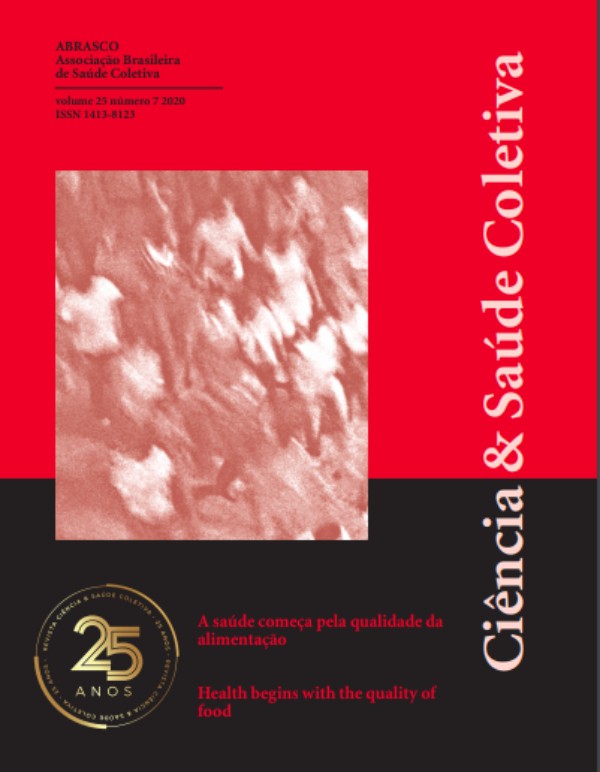0436/2018 - Desnutrição e fatores associados em crianças quilombolas menores de 60 meses em dois municípios do Estado do Maranhão.
Malnutrition and associated factors among maroon children under 60 months of age in two cities of the State of Maranhão.
Autor:
• Victor Nogueira da Cruz Silveira - Silveira, V.N.C - <victorncsilveira@gmail.com>ORCID: https://orcid.org/0000-0002-5271-7412
Coautor(es):
• Luana Lopes Padilha - Padilha, L.L - <luanapadilha13@hotmail.com>ORCID: https://orcid.org/0000-0002-7162-2726
• Maria Tereza Borges Araújo Frota - Frota, M. T. B. A - <mariaterezafrota@gmail.com>
ORCID: https://orcid.org/0000-0001-6889-5785
Resumo:
Objetivo: Avaliar a prevalência de desnutrição em crianças menores de 60 meses residentes em comunidades remanescentes de quilombos de dois municípios do estado do Maranhão e seus fatores associados. Métodos: Estudo transversal com amostra de 372 crianças realizado em agosto de 2015. Foram coletadas informações socioeconômicas, demográficas, maternas e das crianças. A antropometria seguiu o proposto pela Organização Mundial da Saúde. Foram calculados os índices estatura para idade e peso para estatura utilizando o software Anthro versão 3.2.2. Foi realizada regressão de Poisson com variância robusta para a associação da desnutrição com as variáveis estudadas, utilizando o software Stata versão 14.0. Resultados: A desnutrição em crianças foi elevada segundo a estatura-por-idade (15,1%) e peso-para-estatura (7%). Crianças cujas mães possuíam baixa estatura (Palavras-chave:
Pré-escolares; Desnutrição infantil; População negraAbstract:
Objective: To evaluate the prevalence of malnutrition in children under 60 months of age living in quilombos remnant communities of two municipalities in the state of Maranhão and their associated factors. Methods: A cross-sectional study with a sample of 372 children performed in August 2015. Socioeconomic, demographic, maternal and child information were collected. The anthropometry followed the one proposed by the World Health Organization. The stature indexes for age and weight for height were calculated using Anthro software version 3.2.2. Poisson regression was performed with robust variance for the association of malnutrition with the studied variables, using Stata software version 14.0. Results: Child malnutrition was elevated by height-for-age (15.1%) and weight-for-height (7%). Children whose mothers had short stature (Keywords:
Preschoolers; Child nutrition disorders; Blacks.Conteúdo:
Acessar Revista no ScieloOutros idiomas:
Malnutrition and associated factors among maroon children under 60 months of age in two cities of the State of Maranhão.
Resumo (abstract):
Objective: To evaluate the prevalence of malnutrition in children under 60 months of age living in quilombos remnant communities of two municipalities in the state of Maranhão and their associated factors. Methods: A cross-sectional study with a sample of 372 children performed in August 2015. Socioeconomic, demographic, maternal and child information were collected. The anthropometry followed the one proposed by the World Health Organization. The stature indexes for age and weight for height were calculated using Anthro software version 3.2.2. Poisson regression was performed with robust variance for the association of malnutrition with the studied variables, using Stata software version 14.0. Results: Child malnutrition was elevated by height-for-age (15.1%) and weight-for-height (7%). Children whose mothers had short stature (Palavras-chave (keywords):
Preschoolers; Child nutrition disorders; Blacks.Ler versão inglês (english version)
Conteúdo (article):
MALNUTRITION AND ASSOCIATED FACTORS AMONG QUILOMBOLA CHILDREN UNDER 60 MONTHS OF AGE IN TWO CITIES OF THE STATE OF MARANHÃOVictor Nogueira da Cruz Silveira – Centro de Ciências Biológicas e da Saúde, Universidade Federal do Maranhão – São Luís (MA), Brasil. E-mail: victorncsilveira@gmail.com.
Luana Lopes Padilha – Programa de Pós-graduação em Saúde Coletiva, Departamento de Saúde Pública, Universidade Federal do Maranhão – São Luís (MA), Brasil. E-mail: luanapadilha13@hotmail.com.
Maria Tereza Borges Araújo Frota – Departamento de Ciências Fisiológicas, Universidade Federal do Maranhão – São Luís (MA), Brasil. E-mail: mariaterezafrota@gmail.com.
RESUMO
Objetivo: Avaliar a prevalência de desnutrição em crianças menores de 60 meses residentes em comunidades remanescentes de quilombos de dois municípios do estado do Maranhão e seus fatores associados. Métodos: Estudo transversal com amostra de 372 crianças realizado em agosto de 2015. Foram coletadas informações socioeconômicas, demográficas, maternas e das crianças. A antropometria seguiu o proposto pela Organização Mundial da Saúde. Foram calculados os índices estatura para idade e peso para estatura utilizando o software Anthro versão 3.2.2. Foi realizada regressão de Poisson com variância robusta para a associação da desnutrição com as variáveis estudadas, utilizando o software Stata versão 14.0. Resultados: A desnutrição em crianças foi elevada segundo a estatura-por-idade (15,1%) e peso-para-estatura (7%). Crianças cujas mães possuíam baixa estatura (<1,497 m) apresentaram mais chances de possuírem déficit de estatura-para-idade (p<0,05). Nenhuma variável se associou estatisticamente ao baixo peso-para-estatura. Conclusão: A desnutrição infantil persiste como problema de saúde pública em regiões vulneráveis e os fatores maternos como a baixa estatura materna podem explicar a baixa estatura dos filhos. Aponta-se para a necessidade de ações de enfrentamento deste desvio nutricional.
Palavras-chave: Pré-escolares; Desnutrição infantil; População negra.
ABSTRACT
Objective: To evaluate the prevalence of malnutrition in children under 60 months of age living in quilombo remnant communities of two municipalities in the state of Maranhão and their associated factors. Methods: This is a cross-sectional study conducted with a sample of 372 children in August 2015. Socioeconomic, demographic, maternal and child information were collected. The anthropometry followed the one proposed by the World Health Organization. Height-for-age and weight-for-height rates were calculated using Anthro software version 3.2.2. Poisson regression was performed with a robust variance for the association of malnutrition with the studied variables, using Stata software version 14.0. Results: Child malnutrition was high for height-for-age (15.1%) and weight-for-height (7%). Children whose mothers had a short height (<1.497 m) were more likely to have height-for-age deficits (p<0.05). No variables were statistically associated with low weight-for-height. Conclusion: Child malnutrition persists as a public health problem in vulnerable regions, and maternal factors such as low maternal height may explain the short stature of the children. The need for actions to address this nutritional deviation is pointed out.
Keywords: Preschoolers; Child malnutrition; Black people.
INTRODUCTION
The Brazilian black population comprises 8.9% of the population of Brazil and is grouped, especially in the Northeast (11%) and Southeast (9.7%)1. A significant part of this population is concentrated in the poorest strata of the country, as a result of social inequities to which the black race has historically been subjected since the slavery period2,3.
Within the general black population, there is an African Brazilian social group that descends from Africans slaves and lives in isolated rural areas, which in the enslaved period existed as a symbol of resistance and which maintains strong ties with black African culture, namely, the quilombos3. After the end of the slave-holding period, these communities were renamed quilombo remnant communities2.
One of the poorest states in the country, Maranhão concentrates the most significant proportion of black residents (74%)1 and quilombo remnant communities4. Because they serve as a refuge, they are isolated, with poor infrastructure and difficult access to essential services such as health and education5,6.
Due to the consequences of quilombola ancestry, black people have an unequal insertion in the labor market, usually using informal occupations and, consequently, with lower incomes. When compared to white and yellow, blacks earn an average of 1.8 times less7, which reflects on their health and nutrition conditions, especially in more vulnerable segments such as women and children under 60 months.
Among the most significant nutritional deviations in these vulnerable segments is malnutrition. Childhood malnutrition results from the interaction of multiple factors, and their consequences extrapolate adequate growth and development, affecting neurological development and, in extreme cases, result in the early death of the child5,6. Malnutrition is responsible for 30% of the deaths of children under 60 months, reaching 50% in developing countries8.
In Brazil, the malnutrition rate ranks ninth among the causes of infant mortality and is one of the leading causes of death in all the states of the North and Northeast9. In parallel to this scenario, being black is the second major cause of infant death, when based on mortality by color or race10.
Research on the nutritional status of children is scarce in the quilombo remnant communities. Studies to date have found a prevalence of malnutrition ranging from 9.7% in quilombo remnant communities in the State of Alagoas5 to 31.1% in communities in the state of Pará6, showing that child malnutrition still figures as one of the essential nutritional problems in quilombola communities.
Thus, considering the relevance of research of this nature, coupled with the fact that knowing this nutritional scenario of quilombola children can give subsidy for the development of actions and strategies aimed at feeding and nutrition of these communities, this study aims to evaluate the prevalence of malnutrition in children under 60 months of age living in quilombo remnant communities of two municipalities in the state of Maranhão and their associated factors.
METHODS
This is a cross-sectional study integrated with the study “Conditions of Nutrition and Food Safety of Women and Children of Quilombola Communities in Maranhão”, developed with the aim of evaluating the health and nutrition conditions of children under five in quilombola communities in Maranhão and, besides nutritional status, evaluated socioeconomic and demographic aspects, family food insecurity and the anemia status of women and children.
The research was carried out in quilombo remnant communities of the municipalities of Penalva and Viana, Maranhão State, with or without a collective land tenure certificate issued by official bodies. We visited all households in which at least one child under 60 months lived in 27 communities located in the rural area of the mentioned municipalities.
Municipalities were selected by convenience because they were communities where local leaders were receptive to the study. The sample was of the probabilistic type, calculated with a confidence level of 95% and a sampling error of 5%, with reference the percentage of children with malnutrition in the Northeast region of 5.9%11 and adding 20% for eventual losses, totalizing 152 individuals.
The study sample consisted of 373 children under 60 months of age, accompanied by the mother or responsible in reproductive age. In this study, one child who refused to participate was excluded, making up a total sample of 372 children. In the case of two or more children in the same household within the age range of the study, the youngest child was chosen. The criteria for non-inclusion were twin children and those with sickle cell anemia.
Data collection took place in August 2015, after previous contacts with local leaders to request consent and collaboration to carry out the research. Upon reaching the municipality, these leaders intermediated the contact with the Community Health Workers (ACS) of the Family Health Strategy (ESF). From then on, we elaborated the daily scripts in each community, the identification of the families with the desired profile and the orientation of the teams to visit the homes, always accompanied by the ACS responsible for that micro-area and a local community leader.
The Informed Consent Form was signed after the participant agreed to respond to the form. The original copy was retained by the interviewer and a copy was held at the household visited for safekeeping by the respondent. The respondents who were unable to sign their name placed their fingerprint at the signature site.
The interviews were carried out at the child’s household through an adapted, validated and pre-codified form12, applied with priority to the biological mother and, in her absence thereof, with the legal guardian or caregiver of the child, provided that she lived in the same household, met the age prerequisite and could provide the requested information.
At the same time, anthropometric measures were taken according to WHO recommendations (2006)13. The children’s weight was gauged using the Omron® brand (Omron Healthcare Inc. U.S.A.), HBF 214 model, with a 150 kg capacity and 100 g scales. Children under two years of age were weighed together with the mother with a subsequent weight reduction calculation13.
The length of children under two years of age was measured in a horizontal position by the infantometer Sanny® brand, with 100 cm breadth. The height of children older than two years was gauged by the Alturexata® anthropometer, ranging from 0 to 2.13 m and subdivisions of 0.1 cm. All subjects were weighed and measured without shoes, wearing only light clothing. Two measurements of weight and height were assessed and recorded on the form. The mean of each measurement was used for the analysis. The interviewers worked in pairs in the anthropometric measurements. New measurements were taken when the two measures of weight differed by more than 100 g and those of height by more than 1.0 cm13.
The children were evaluated according to the anthropometric indices weight-for-height (W/H) and height-for-age (H/A) calculated in Z score using the software Anthro version 3.2.214 based on the current population of reference13. Cut-off points for nutritional status assessment were established according to the WHO (2006)13.
At the end of each workday, the interviewers checked and coded the forms, which were reviewed by the field supervisor, in order to detect fill-in gaps that required an immediate return to the previously visited household. Then the interview control worksheet was filled out to evaluate the coverage of the target for that location and the forms were filed and kept.
After interviewing and collecting the nutritional data, the field team guided the families of the individuals studied regarding adequate and healthy diet. Participants who evidenced a nutritional risk or a positive result for anemia were referred to the Primary Healthcare Facility of that micro-area.
Data were double-entered in the Epi-info program, version 3.5.2, in order to identify entry inconsistencies. For the analysis of the data, the program STATA®, version 14.0 was used. Factors associated with children malnutrition were identified in two stages. In the bivariate analysis, the simple Poisson regression was used to identify the independent variables that showed associations with the nutritional deficits (p <0.20) that were selected to compose the multiple models. In the second step, the factors associated with height-for-age and weight-for-height were identified using a multiple, hierarchical analysis Poisson regression (robust standard error) using an adapted conceptual model15 (Figure 1):
- Block 1 - Socioeconomic and demographic factors: gender of the child and head of the household, child\'s age, schooling and labor relationship of the head of the household, household income, total number of people residing in the household, participation in the Family Grant Program and the Economic Classification Criteria Brazil;
- Block 2 - Access to services and housing conditions: Sanitary sewage, waste disposal, origin and treatment of water;
- Block 3 - Maternal factors: age, total and exclusive breastfeeding, height and BMI;
- Block 4 - Healthcare and nutrition: Visit of the community health worker and coverage of the Family Health Strategy;
- Block 5 - Birth characteristics: Birth weight;
- Block 6 - Child morbidities: Diarrhea, cough and fever in the last two weeks
We started the analysis of the multiple model from the distal to the proximal block. The variables with a p-value <0.20 by Poisson regression with robust variance were selected as a factor associated with nutritional deficits and remained in the multiple models in subsequent block analyses. In the final model, the one with a p-value <0.05 was considered as a statistically significant variable after all the adjustments.
The Research Ethics Committee of the Federal University of Maranhão approved the project under Opinion N° 1.627.919 as per the requirements of the Resolution CNS 466/12 of the National Health Council and its amendments.
RESULTS
The mean age of the children studied was 23.1 ± 15.7 months. All the characteristics evaluated are described in Tables 1 and 2. The prevalence of H/A deficit was 15.1% (95% CI: 11.4-18.7) and of W/H deficit was 7.0 % (95% CI: 4.4-9.6).
Table 3 shows the bivariate analyzes that associated with the H/A deficit. The variables associated with the outcome were: the child’s age, gender of the head of the household and the social class of the socioeconomic and demographic block, the sanitary sewage of the block of access to services and housing conditions, the tertile of the maternal height of the block of maternal factors, birth weight of the birth characteristics and presence of diarrhea and fever in the last two weeks of the infant’s morbidities block (p <0.20).
The variables associated in the bivariate analysis were submitted to a multiple and hierarchical analysis of the H/A deficit. The maternal height tertile was the only factor associated with this outcome (PR: 4.08, 95% CI: 1.95-8.52; p <0.001), showing that the deficit of this rate was more prevalent in the children of women with height below 1,497 m (Table 3).
Table 4 shows the bivariate analyses that were associated with the W/H deficit, namely: the age of the child of the socioeconomic and demographic block; and the tertile of maternal height and BMI of the maternal factors block (p <0.20). No variables were associated with this outcome in the multiple analysis (p> 0.05).
DISCUSSION
This study observed a high prevalence of malnutrition, considered mild severity for the H/A deficit and moderate for the W/H deficit16. The factors associated with stunting were the lower maternal height, and, initially, the child’s age and maternal height were associated with wasting.
The high prevalence of malnutrition observed here is related to the environmental factors of the families of the children evaluated, which are mostly included in lower economic classes and with lower purchasing power.
Controversially, the mean Z-score of the H/A indicator (-0.74) of the children evaluated was closer to the adequacy value (-2.0), when compared to the national average (-1.32), meanwhile the mean W/H (-0.12) was lower than the national average (0.17)17.
The height-for-age deficit is commonly associated with long-term food deprivation and frequent infections5,6,17-21. Restrictions on linear growth tend to occur before two years of age with severe effects under the child’s psychomotor development, especially in school performance22-25. However, in this study, the prevalence of height deficit was evenly distributed among all the children’s age groups.
The prevalence of height deficit found exceeded that of other studies with Brazilian children with or without black ancestry2,5,6,11,15,18,19-23,26. The highest prevalence of global stunting is in South Asia (46%) and Sub-Saharan Africa (38%)25. The value found here neared that found for Latin America and East Asia (16%)25, while it was almost half the prevalence of developing countries (32%)25, in which Brazil ranks.
The height deficit prevalence of 15.1%, observed in this study is five times that of the reference population (2-3%)27, evidencing the level of nutritional risk to which quilombola children are exposed. It is observed that residents of traditional communities such as these still live with limitations regarding improving their nutritional status, such as low income and schooling, informality in labor relationships and difficult access to goods and services, factors partially overcome by the rest of the Brazilian child population1,7.
In this study, low maternal height was the only variable associated with height deficit in children younger than 60 months. Admittedly, women with lower heights tend to generate concepts with equally low length and likely limited growth in comparison with the children of women with normal or high height15,24,27. This relationship may be associated with restricted development and growth in the maternal uterus, as well as perpetuating the cycle of chronic malnutrition due to the maintenance of low height through subsequent generations28,32.
Although maternal height is also known for its cause-effect relationship with low birth weight, this study did not evidence any association of birth weight with restrictions on children’s linear growth22,29,30.
Low weight-for-height is one of the strongest indicators of infant mortality for the under-five age group25. It is commonly associated with more acute forms of food deprivation or infectious episodes25, unlike H/A. The prevalence of deficit in this indicator was higher than the one reported in the scientific literature5,6,15,18,19,21,23,25,31,32.
A systematic review of the nutritional status of Brazilian children revealed that the wasting breadth ranged from 0-5%29, classified as a problem of mild severity16. The overall prevalence of this disease is 7.7%31, and the highest prevalence levels in the world are in South Asia (16%) and Sub-Saharan Africa (7.8%)31. The value found in this study is also close to the prevalence observed in developing countries (7.7%)31. In this study, the deficit found was also higher than expected for the reference population (2-3%)27, more than twice the upper limit.
Weight-for-height was homogeneous when distributed by children’s gender. However, when classified by age, we observed that children younger than 24 months had a higher propensity to develop low weight, corroborating data from the literature that indicate the population of under two years of age as the most affected in delayed weight gain5,32.
The emaciation caused by the deficit in this indicator portrays a rupture in the child’s physical harmony13,15, possibly caused by inadequate weight gain, despite normal growth or temporary weight loss due to common childhood morbidities, such as cough and diarrhea34. However, this study did not find an association of morbidity episodes with the deficit in this indicator, probably attributing to the W/H deficit the reduced weight gain, which could not be evaluated due to the cross-cutting nature of this study.
The prevalence of weight and height deficits suggests that quilombola children under 60 months of Penalva and Viana still live with inaccessibility to essential services. The prevalence levels closest to those found in this study were in poorer geographic regions, mainly on the African continent, where the ancestors of quilombo remnants originate2,5,6,11,15,18,19-23,25,26,31,32.
This work’s design was limited regarding data collection in two municipalities of the same geographic region, without taking into account the distribution of the quilombola population in other municipalities in Maranhão, which does not allow to infer these results for all quilombola communities in the state. Also, the lack of food intake assessment of this population restricted the verification of inadequacies in the children’s diet, which could explain the malnutrition found.
The survey of information in a representative sample in the quilombo remnant communities in the state of Maranhão is a pioneer initiative to analyze the nutritional situation of this population, which can improve understanding of malnutrition in specific populations in one of the poorest states of the country and, therefore, to direct increases in the public policies for this specific population group.
CONCLUSION
This study observed a high prevalence of height deficit and low weight-for-height in the sample of quilombola children in two municipalities in the state of Maranhão. The lower maternal height was related to infant height deficit. The results expose the situation of social inequity and invisibility to which this population is submitted and point to the need for public policies that aim to compensate for the historical neglect of the State towards this population segment.
Acknowledgments
We are grateful to the State Health Secretariat of Maranhão and the Secretariat for the Promotion of Racial Equality Policies for the logistical and financial support. We are also grateful to the Santo Antônio dos Pretos Association for their support and permission to conduct the research, as well as all who have contributed directly or indirectly to this work.
BIBLIOGRAPHY
1. Instituto Brasileiro de Geografia e Estatística (IBGE). Pesquisa Nacional por Amostra de Domicílios. Brasília: IBGE; 2016.
2. Ministério do Desenvolvimento Social e Combate à Fome (MDS). Cadernos de Estudos: Quilombos do Brasil: Segurança alimentar e nutricional em territórios titulados. Brasília: MDS; 2014.
3. Lindoso D. A razão quilombola: estudos em torno do conceito quilombola de nação etnográfica. Maceió: EDUFAL; 2011.
4. Ministério do Desenvolvimento Social e Combate à Fome (MDS). Guia de Cadastramento de Famílias Quilombolas. Brasília: SENARC/MDS; 2015.
5. Leite FMB, Ferreira HS, Bezerra MKA, Assunção ML, Horta BL. Consumo alimentar e estado nutricional de pré-escolares das comunidades remanescentes de quilombos do estado de alagoas. Rev Paul Pediatr 2013; 31(4):444 – 51.
6. Guimarães RCR, Silva HP. Estado nutricional e crescimento de crianças quilombolas de diferentes comunidades do estado do Pará. Amazonica 2015; 7(1):186 – 209.
7. Instituto Brasileiro de Geografia e Estatística (IBGE). Pesquisa Nacional por Amostra de Domicílios Contínua. Brasília: IBGE; 2017.
8. Frempong RB, Annim SK. Dietary diversity and child malnutrition in Ghana. Heliyon 2017; 3(5): 1 – 21.
9. França EB, Lansky S, Rego MAS, Malta DC, França JS, Teixeira R et al. Principais causas da mortalidade na infância no Brasil, em 1990 e 2015: estimativas do estudo de Carga Global de Doença. Rev Bras Epidemiol 2017; 20(1S): 46 – 60.
10. Caldas ADR, Santos RV, Borges GM, Valente JG, Portela MC, Marinho GL. Mortalidade infantil segundo cor ou raça com base no Censo Demográfico de 2010 e nos sistemas nacionais de informação em saúde no Brasil. Cad. Saude Publica 2017; 33(7): 1 – 13.
11. Ministério da Saúde (MS). Pesquisa Nacional de Demografia e Saúde – 2006 (PNDS 2006): Dimensões do Processo Reprodutivo e da Saúde da Criança. Brasília: MS; 2009.
12. Universidade Federal do Pernambuco (UFPE). III Pesquisa Estadual de Saúde e Nutrição: Saúde, Nutrição, Alimentação, Condições Socioeconômicas e Atenção à Saúde no Estado de Pernambuco. Recife: UFPE; 2010.
13. World Health Organization (WHO). Child growth standards: length/height-for-age, weight-for-age, weight-for-length, weight-for-height and body mass index-for-age: methods and development. Geneva: WHO; 2006.
14. World Health Organization (WHO). Child growth standards: WHO Anthro (versão 3.2.2.) e macros. Geneva: WHO; 2011.
15. Souza OF, D’Aquino Benício MH, Castro TG, Muniz PT, Cardoso MA. Desnutrição em crianças menores de 60 meses em dois municípios no estado do Acre: Prevalência e fatores associados. Rev Bras Epidemiol 2012; 15(1):211 – 21.
16. World Health Organization (WHO). WHO global database on child growth and malnutrition. Geneva: WHO; 1997.
17. Instituto Brasileiro de Geografia e Estatística (IBGE). Antropometria e análise do estado nutricional de crianças e adolescentes no Brasil. Brasília: IBGE; 2006.
18. Barroso MMB, Salvador LM, Neto UF. Desnutrição proteico-calórica grave em dois irmãos devido ao abuso por privação alimentar. Rev Paul Pediatr 2016; 34(4):522 – 27.
19. Pedraza DF, Oliveira MM, Cardoso MVLML, Araujo EMN, Rocha ACD. Índices antropométricos de crianças assistidas em creches e sua relação com fatores socioeconômicos, maternos e infantis. Cien Saude Colet 2016; 21(7):2219 – 32.
20. Pedraza DF, Rocha ACD, Sousa CPC. Crescimento e deficiência de micronutrientes: perfil das crianças assistidas no núcleo de creches do governo da Paraíba, Brasil. Cien Saude Colet 2013; 18(11):3379 – 90.
21. Pedraza DF, Silva FA, Melo NLS, Araujo EMN, Sousa CPC. Estado nutricional e hábitos alimentares de escolares de Campina Grande, Paraíba, Brasil. Cien Saúde Colet 2017; 22(2):469 – 77.
22. Vargas CL, Benedetti FJ, Weinmann ARM. Crescimento de prematuros até os dois anos de vida: revisão integrativa da literatura. Rev Bras Crescimento desenvolv Hum 2017; 3(1):72 – 84.
23. Pereira IFS, Andrade LMB, Spyrides MHC, Lyra CO. Estado nutricional de menores de 5 anos de idade no Brasil: evidências da polarização epidemiológica nutricional. Cien Saude Colet 2017; 22(10):3341 – 52.
24. Araújo TS, Oliveira CSM, Muniz PT, Silva-Nunes M, Cardoso MA. Desnutrição infantil em um dos municípios de maior risco nutricional do Brasil: estudo de base populacional na Amazônia Ocidental Brasileira. Rev Bras Epidemiol 2016; 19(3):554 – 66.
25. United Nations Children’s Fund (UNICEF). Progress for Children: A World Fit for Children Statistical Review (nº 6). New York: UNICEF; 2007.
26. Ministério do Desenvolvimento Social e Combate à Fome (MDS). Chamada Nutricional Quilombola. Brasília: SEPPIR/MDS; 2007.
27. Monteiro CA; Onis M; Clugston G. The worldwide magnitude of protein-energy malnutrition: an overview from the WHO Global Database on Child Growth. Bulletin of the World Health Organization 1993; 71:703 – 12.
28. Black RE, Victora CG, Walker SP, Bhutta ZA, Christian P, Onis M, Ezzati M, Grantham McGregor S, Katz J, Martorell R, Uauy R. Maternal and child undernutrition and overweight in low-income and middle-income countries. Lancet Child Adolesc Health 2013; 382(9890):427 – 51.
29. Pedraza DF, Souza MM, Cristóvão FS, França ISX. Baixo peso ao nascer no Brasil: revisão sistemática de estudos baseados no Sistema de Informações sobre Nascidos Vivos. Pediatria Moderna 2014; 50(2):51 – 64.
30. Gonçalves FCLSP, Lira PIC, Eickmann SH, Lima MC. Razão peso/perímetro cefálico ao nascer na avaliação do crescimento fetal. Cad Saude Publica 2015; 31(9):1995 – 2004.
31. International Bank for Reconstruction and Development (IBRD). Prevalence of wasting, weight for height (% of children under 5). Washington: IBRD; 2016.
32. Pedraza DF, Menezes TN. Caracterização dos estudos de avaliação antropométrica de crianças brasileiras assistidas em creches. Rev Paul Pediatr 2016; 34(2):216 – 24.
33. Pedraza DF, Sales MC, Menezes TN. Fatores associados ao crescimento linear de crianças socialmente vulneráveis do Estado da Paraíba, Brasil. Cien e Saude Colet 2016; 21(3): 935 – 45.
34. Pedraza DF. Hospitalização por doenças infecciosas, parasitismo e evolução nutricional de crianças atendidas em creches públicas. Cien e Saude Colet 2017; 22(12): 4105 – 14.













